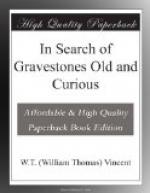Fig. 2.—At Newhaven, Sussex.
The words below were:
“To the memory of Thomas, the son
of
Thomas and Ann
Alderton, who departed
this life the
10th day of April 1767, in the
13th year of his
age.”
The same artist almost of a certainty produced both of these figurative tombstones. The handicraft is similar, the idea in each is equally daring and grotesque, and the phraseology of the inscriptions is nearly identical. I thought both conceptions original and native to the place, but I do not think so now. In point of taste, the first, which is really second in order of date, is perhaps less questionable than the other. The hope of a joyful resurrection, however rudely displayed, may bring comfort to wounded hearts; but it is difficult to conceive the feelings of bereaved parents who could sanction the representation of a beloved boy, cut off in the brightest hour of life, coffined and skeletoned in the grave!
[Illustration: Fig. 3. Widcombe.]
[Illustration: Fig. 4. Newhaven.]
[Illustration: Fig. 5. Lewes.]
Above the coffin on Alderton’s headstone is an ornament, apparently palms. It is not unusual to find such meaningless, or apparently meaningless, designs employed to fill in otherwise blank spaces, though symbols of death, eternity, and the future state are in plentiful command for such purposes. Something like this same ornament may be found on a very old flat stone in the churchyard of Widcombe, near Bath. It stretches the full width of the stone, and is in high relief, which has preserved it long after the accompanying inscription has vanished. The probable date may be about 1650.
Fig. 3.—At Widcombe, near Bath.
In Newhaven Churchyard, though there are but these two striking examples of the allegorical gravestone, there is one other singular exemplification of the graver’s skill and ingenuity, but it is nearly a score of years later in date than the others, and probably by another mason. It represents the old and extinct bridge over the Sussex Avon at Newhaven, and it honours a certain brewer of the town, whose brewery is still carried on there and is famous for its “Tipper” ale. Allowing that it was carved by a different workman, it is only fair to suppose that it may have been suggested by its predecessors. Its originality is beyond all question, which can very rarely be said of an old gravestone, and, as a churchyard record of a local institution, I have never seen it equalled or approached.
Fig. 4.—At Newhaven, Sussex.
Under the design is the following inscription:
“To the Memory of Thomas Tipper,
who
departed this
life May y’e 14th, 1785, Aged
54 Years.




